As massage therapists who interface with the public, we are affected by demographic shifts and trends influencing the population. One of those trends is certainly the movement toward an aging population, not just in the United States, but across many countries in the developed world. This shift is due, in part, to the fact that longevity is increasing, in no small part to improvement in the treatment and prevention of infectious diseases. Due to an increasingly aging population, we are seeing more conditions associated with aging, chief among them being osteoarthritis. In short, people are living long enough to have these problems. Arthritis is now one of the leading reasons for disability, restriction in movement, and chronic pain, all of which negatively affect quality of life.
In cases where osteoarthritis is advanced and severely affects mobility and quality of life, the advent of joint replacements, specifically of the hip and knee, has changed the trajectory of life for many people. In this article, we will focus specifically on total knee replacements, or total knee arthroplasty (TKA). In my practice, the amount of people I see post-TKA far outnumbers the people I see who have symptoms after hip replacement. Somewhat surprisingly, the majority of hip replacement patients do well with very little therapy after the procedure. My conversations with other clinical massage therapists and physical therapists confirm that their experience is the same. It is likely you have had a similar experience in your practice as well.
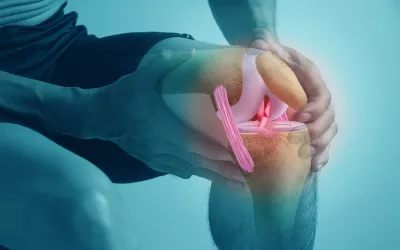
When addressing any musculoskeletal condition, the deeper your understanding, the better your outcomes. Rather than a technique-first approach, the more we fully understand the context of the problem, the more likely we are to construct a treatment protocol that can potentially make a significant positive difference in the client’s quality of life. Treatments are answers; first make sure you fully understand the question. The goal of this article is to deepen your understanding of the ways that massage therapy can accelerate recovery and complement other disciplines, such as physical therapy. There is much we have to add in the service of the thousands of people who have had a knee replacement and wish to have the best possible outcome.
First, let’s look at the data. Across the nation, the number of knee and hip replacements continues to grow every year. The total number of replacements in the US (both hip and knee) in 2023 was 3.7 million.1 In 2023, the number of TKAs alone was about 1.3 million, and estimates are that by 2030, that number in the US will be about 3.4 million. Compared to the year 2000, the annual rate of TKAs in the US has more than doubled, particularly for individuals aged 45–64.
One projected factor for the significant increase is the change in the criteria for TKAs, as early procedures were limited to people with severe pain and mobility restrictions. In recent years, the age range for replacement has expanded in both directions (younger people as well as patients at a more advanced age) and now includes patients with far less pain and dysfunction than previously thought to qualify for a TKA. The success rate of knee revisions is far less than the initial replacement, so orthopedic physicians keep that in mind regarding age, as the hope is that the initial prosthesis will not have to be replaced.
Varying Degrees
As with any surgery, there are variations in how it is done, and those variations change the trajectory and nature of the recovery. Regarding the ligaments of the knee, the medial collateral ligament (MCL) and the lateral collateral ligament (LCL) are always spared, as they serve an important stabilizing role for the new knee. The anterior cruciate ligament (ACL) is removed, but surgeons vary on whether they keep the posterior cruciate ligament (PCL) or remove it. With the surrounding muscles, there are also several variations. In the traditional approach, the surgeon made a vertical cut through the vastus medialis to splay the patella to the side, thus giving access to the joint. There are now several new approaches, both manual and robotic, that are vastus-sparing, where no cuts in the muscle are made. Instead, the muscle is moved to the side to gain access to the joint. TKA approaches that do not cut the muscle generally have faster and less painful recoveries. It is certainly worth asking the client if they know which approach the surgeon used, although if the incision is off to the medial aspect of the knee, the surgeon likely used a new vastus-sparing approach.
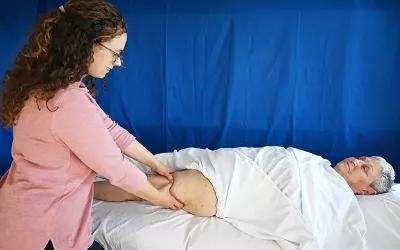
Working with clients who have had a TKA also offers the perfect opportunity to collaborate with other health-care providers, most likely physical therapy in this case, as there are very few orthopedists who do not refer their TKA patients for physical therapy after their procedure. There are important benchmarks of improvement post-procedure that have significant impact on long-term outcomes. This is an ideal opportunity to demonstrate the complementary impact of massage therapy in meeting those goals in conjunction with the physical therapy colleagues in your community. One of my clinic locations makes collaboration easy, as the space is shared with five manual therapy-oriented physical therapists. We have the advantage of working in the same location, but collaboration can easily transcend physical boundaries with good communication strategies.
Treatments are answers; first make sure you fully understand the question.
For most people receiving TKA, the surgery cannot come soon enough. They are having the knee replaced because of significant pain and limitation of movement. Walking is generally limited to short distances and stairs are typically avoided when possible. The greater their pain, the more this is true. This, however, can lead to another problem. Understandably, the person believes that the problem is in the joint, and replacement will correct everything. Unfortunately, it’s not that simple. The people with the greatest limitation are also the people who have been the most sedentary and are often in very poor muscular health at the time of the surgery. This is perfectly understandable, as it is hard to exercise when movement is painful. After surgery, the focus of the rehabilitation is not on the joint, but on the muscles and tissues that affect the joint—the very muscles that have been neglected and compromised. This may explain why, even though TKA has generally very high satisfaction rates, there are many people—perhaps as many as 1 in 5 patients—who have unsatisfactory results.2 Their complaints are mostly chronic pain, persistent knee stiffness, limited range of motion (ROM), joint swelling, and decreased function after TKA.
As you can see, these conditions are due to the response of the surrounding tissues; seldom is it an inherent problem with the replacement itself. For most people, examination of the replacement shows that the joint itself is intact and functioning well. Yet, they are in significant discomfort. This is where we can help, and the process can begin before the surgery.
Before the Procedure
To increase the likelihood of success with rehabilitation, prehabilitation (prehab) is a perfectly logical response. The healthier the tissue is going into the procedure, the better the client’s chances of satisfactory outcomes. Here is where massage therapy may play an important role. If we can bring benefit to the tissue by manual means in combination with prehab from physical therapy, these efforts are likely to increase the positive outcome after surgery. The addition of massage therapy to prehab makes perfect sense, and while there is little research data to back this up, my experience in the clinic reflects this assertion.
Traditionally, prehab has referred to a structured exercise program designed to increase the strength of the quadriceps muscles by doing activities like “Sit to Stand,” “Timed Up and Go,” and ROM. Increasing quadriceps strength before surgery will change the baseline from which the patient begins the strengthening after surgery. The trauma of the procedure itself will reduce quadriceps strength by about 60 percent, with some deficit that may last a lifetime.3 Starting from the best possible functional baseline will positively affect future outcomes.
Patients who do not have full knee extension before surgery are also often the patients with poorer outcomes after surgery. The inability to fully straighten the knee also affects the hip joint, most often keeping the person in a slightly forward position, shortening the hip flexors. This flexed posture increases the load on the lumbar spine as well, compounding the problem and the number of potential hurdles after surgery. The more of these structural and functional challenges that can be improved before surgery, the less daunting and difficult the rehabilitation process becomes.
There are several potential goals for massage therapy in the prehab phase. A reasonable protocol before surgery might include a focus on each of the quadriceps muscles to maximize their functional capacity. Hamstring muscles and gastrocnemius muscles should be treated for their ability to limit knee extension and, thus, full range of the joint. It is also important to address hip mobility, especially hip extension, and the health of the gluteus medius, which stabilizes the pelvis in single leg standing.
The main benefits of adding massage therapy are potentially twofold: pain reduction and the ability to make movement more comfortable. As noted earlier, the reason the person is having this procedure is pain and movement limitation. The exercises prescribed by the physical therapist will challenge muscles that are already compromised, so this discomfort presents a significant obstacle to compliance. If we can make movement more comfortable, it is more likely the person will be able to do the exercises needed to increase their strength. Compliance is one of the greatest challenges with prehab exercises, and we can potentially play a role in making the exercises less uncomfortable.
What are the cellular mechanisms that make massage therapy effective in the rehab process? Multiple mechanisms may be at play. Studies at the University of Kentucky, Harvard University, and several other universities have shown that mechanical stimulation (via compression) to muscle tissue can create significant measurable tissue changes. The study at Harvard in 2016 used a cyclic compression to injured tissue and found that the treated tissue had more than a twofold increase in muscle regeneration, reduced fibrosis, and a visible increase in the density of the cells. Treated muscles also had fewer neutrophils in their tissue than untreated muscles, which may suggest that the reduction in cytokines that attract them had caused the decrease in neutrophil infiltration, supporting the idea that massage may indeed decrease inflammation.4
At the University of Kentucky, researcher Dr. Ester Dupont-Versteegden found that massage is immunomodulatory: It can change immune responses to benefit muscle health, particularly in advanced age.5 During recovery from disuse, massage is beneficial in remodeling the extracellular matrix by changing gene expression in cells responsible for collagen remodeling.
Massage therapists may also play an important role before surgery by providing education. Even if clients are not in a formal prehab protocol, they might be coming to visit massage therapy for pain relief while awaiting surgery. This is a wonderful time to educate them as to the importance of prehabilitation and to mentally prepare the client for the work ahead after surgery, rather than leaving clients thinking that the joint replacement will completely and immediately solve their problem.
As a rather ironic example, I just took a break from writing this article to run to the clinic to see someone who has lingering pain and swelling in her knee after TKA. She relayed to me that she had physical therapy before the surgery, but thought it was a waste of time because physical therapy wasn’t going to solve her knee issue. I didn’t say anything at the time but thought how sad it was that no one explained to her how important this could be toward improving her outcomes after the surgery. Other clients have told me that the hospital provided a one-hour seminar on how to prepare for TKA and recommended some exercises as well. Simply suggesting some exercises is hardly likely to encourage many patients to follow through. We can amplify the messaging from our physical therapy colleagues and the research about prehab as we spend so much time with clients, a luxury that most other health-care providers do not have. In addition, research suggests that massage therapists can also have positive effects linked to the interaction (therapeutic alliance) between the therapist and client, which can help reduce postoperative anxiety and thus pain perception. All the more reason for educated massage therapists to see clients before a scheduled TKA.
After the Surgery
Most of the clients I see after TKA present to my office about four weeks after the procedure. If your skills include manual lymphatic drainage and you have permission from the client’s doctor, you might indeed see them sooner to address the swelling that inevitably happens after the procedure. This swelling can create joint stiffness and discomfort and negatively affect quadriceps function.
In addition to treatment, teaching the client simple approaches they can use at home to manage lymphatic flow can be enormously helpful. For massage therapists who work in settings where they might see the client early in the recovery process, there is research data to support the idea that massage therapy can decrease postoperative pain, measured at the 7-, 14-, and 21-day periods.6
Goal No. 1: Knee Extension
The first goal of rehabilitation is to achieve full knee extension, which may seem counterintuitive, as most therapists might assume that flexion of the knee is the first goal. Extension is important for several reasons. From a structural viewpoint, a knee that is slightly flexed shortens the leg length on that side of the pelvis. This pelvic unleveling (pelvic obliquity) can cause a host of problems up and down the kinematic chain. To experience this for yourself, simply stand with one leg flexed and feel the way your spine and pelvis have to accommodate the asymmetry. A level pelvis gives the spine a balanced foundation.
Secondly, as mentioned earlier, the quadriceps muscles are weakened after surgery, often significantly so. If you do not have full knee extension while standing, you are loading the already compromised quadriceps by doing essentially a mini-squat. This loading of the quadriceps will result in reduced walking efficiency, faster tiring, and increased energy expenditure for daily tasks. With full knee extension, the weight is born largely by the skeletal system, taking some of the burden away from the compromised muscle. Feel the difference the next time you use a leg press machine. The moment your knees are in full extension, the stress of the weight is negligible as the skeletal system bears the load. Bend your knee just a bit, and the challenge to the quadriceps is easily felt.
Just as importantly, the knee should come to full extension during the transition from mid-stance to terminal stance in the gait cycle. If you cannot do that and the load is on a flexed knee, the overloaded quadricep might give way during that transition and the likelihood of falling goes up exponentially. Adding to that, if you do not have a fully extended knee during terminal stance, the foot contacts the ground in a plantarflexed position, resulting in a deactivation of the tibialis anterior. This will increase the likelihood of stubbing the toe during gait, and thus tripping is a real possibility. Trips and falls are the last thing a recent surgical patient needs. This is why TKA patients need an educated therapist to monitor the quality of their gait, not just the quantity of their steps. Just because someone can walk 1,000 feet does not mean they can do so safely and efficiently.
Full extension is also important in maximizing the ability for the muscular system to help venous return and fluid exchange via muscular contraction (essentially a low-pressure pump mechanism). If the ROM is compromised, fluid exchange and venous return are compromised as well. In addition to the hamstrings, the gastrocnemius, which crosses the knee, may play an important role in limiting knee extension, even though the soleus, which doesn’t cross the knee, may have a more direct role in venous return.
Yet another reason for treating hamstrings is their relationship to quadriceps function (Images 2 and 3). After surgery, the hamstrings are often hypertonic as a protective mechanism, which is certainly understandable. If the hamstrings are overly activated, the principle of reciprocal inhibition results in a decrease of activation of the antagonist, the quadriceps. (As if the quadriceps didn’t have enough challenges!) As a reminder, reciprocal inhibition states that when an agonist contracts, its antagonist is neurologically inhibited. When flexors flex, extensors must let go and extend. Our soft-tissue treatment goal is to decrease hypertonicity in the hamstrings and encourage a full ROM (extension) as soon as possible.
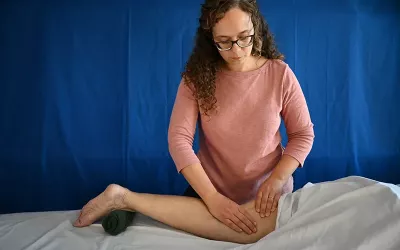
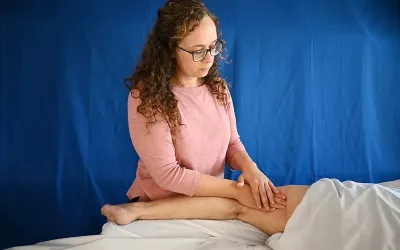
Goal No. 2: Flexion Range of Motion
After TKA, knee flexion ROM will be significantly compromised due to the trauma of the surgery itself and likely a history of reduced ROM before the surgery. In surgeries where the muscle is cut, wound healing and the potential for scar tissue formation all challenge flexion capability. Even in vastus-sparing surgeries, the muscle is severely stretched to make room to insert the components of the prosthesis. The target goal for treatment is to help the client achieve 120 degrees of knee flexion, and the sooner this is accomplished, the better. The longer ROM is restricted after surgery, the more likely scar tissue will develop, making improvements in ROM more difficult.
Goal No. 3: Quadriceps Activation
As you might imagine, the process of aggressively stretching the quadriceps after TKA isn’t comfortable, and the discomfort can be an impediment to patient compliance. The addition of soft-tissue mobilization at this point can be enormously helpful in making this process more comfortable and stretching protocols more effective. Targeted massage therapy can make the difficult task of stretching more tolerable, and thus the patient is more likely to continue doing the stretches that will increase their odds of positive outcomes.
A muscle that is capable of contracting still relies on a neural signal/connection to make that happen. During the trauma of surgery, where the quadriceps are massively stretched, the patient can also lose the ability to volitionally contract a muscle, which is called arthrogenic muscle inhibition, where muscle contraction is limited even when there is no damage to the nerve or the muscle itself. What the client experiences is that the quadriceps seem to be “offline”; they struggle with contracting the muscle at will or the contraction is delayed. This delay can be seen when having the client do a straight leg raise. As they lift one leg, the lower leg will lag behind due to delayed quadriceps firing, producing a flexed knee anywhere from 15–20 degrees. Helping the client access the muscle through touch can be a fascinating application of hands-on approaches centering on the nervous system.
The use of touch to deepen proprioception and interoception has a rich history and has been used in many forms of bodywork in various ways. In the context of a client after TKA, the massage therapist can use touch to cue the client’s nervous system discovery and improve neuromuscular control.
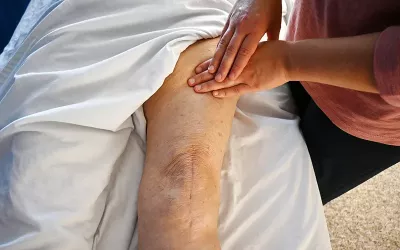
In addition to arthrogenic inhibition, another form of neurologic inhibition, called motor inhibition, can come from tissue disturbances from the muscle itself. In essence, muscles have one task, which is to contract. If there is a tissue disturbance in the muscle, it will do that one job less well, which will then display as weakness. True weakness and weakness from motor inhibition both result in a lack of strength, altered firing, and muscle recruitment. Their cause, however, is very different, and strength training (a form of overloading) a muscle with motor inhibition is likely to increase symptoms and impede progress, which is very discouraging to the client.
If we, by manual means, can treat these areas, real progress can happen, as the exercises now increase strength and reduce symptoms, instead of aggravating the muscle and increasing symptoms. When exercises increase symptoms, it doesn’t motivate clients to continue. Precise hands-on treatment can be very effective in these circumstances. I have used this approach with hundreds of clients over the decades, often seeing clients who failed at strength training. The increase in strength and clarity of muscle firing is immediately apparent after treatment, both to the therapist and more importantly, the client. For my physical therapy colleagues, it can help turn their most challenging patients into success stories. It’s a win-win for everyone, most importantly the client.
Lastly, having the TKA is a chance to address the total musculoskeletal system and context that may have preceded the surgery. The altered gait that came with knee pain and the many musculoskeletal compensations may have been in existence for years. Those altered movement patterns often now feel completely normal and may be independent of the knee arthritis that started this in the first place. I remember one of my clients raving about how much better she was after her TKA. She had zero pain for the first time in years and felt no limitations in movement.
“Then why are you still limping?” I asked.
“I’m not,” she replied, rather defensively.
After I showed a video I had taken of her gait, she was stunned to realize she kept the compensation (limping) even when the problem (knee pain) was no longer there. Great massage therapy and bodywork can help the system “reboot” based on current information, not historical information. All this is possible with the gift of educated hands that reflect information back to the nervous system.
In your practice treating people with musculoskeletal discomfort, it is highly likely that you are already seeing clients after TKA and will see many more in the future. Even before the surgery, there are many ways that precise soft-tissue strategies and client education can maximize the outcomes of the surgery. It is my hope that the strategies in this article can increase your effectiveness, help you collaborate with other health-care providers, and provide the best service possible to your TKA clientele.
Notes
1. Sean P. Ryan et al., “Highlights of the 2023 American Joint Replacement Registry Annual Report,” Arthroplasty Today 26 (February 2024): 101325, https://doi.org/10.1016/j.artd.2024.101325.
2. Volodymyr Staude et al., “Complex Rehabilitation Treatment After Knee Arthroplasty,” Orthopaedics, Traumatology and Prosthetics 1–2 (2022): 12–9, https://otp-journal.com.ua/article/view/263035; Anil Bhave et al., “Functional Problems and Treatment Solutions After Total Hip and Knee Joint Arthroplasty,” The Journal of Bone and Joint Surgery 87, suppl. 2 (December 2005): 9–21, https://doi.org/10.2106/jbjs.e.00628.
3. Marianne Walsh et al., “Physical Impairments and Functional Limitations: A Comparison of Individuals 1 Year After Total Knee Arthroplasty with Control Subjects,” Physical Therapy 78, no. 3 (March 1998): 248–58, https://doi.org/10.1093/ptj/78.3.248.
4. Christine A. Cezar et al., “Biologic-free Mechanically Induced Muscle Regeneration,” Proceedings of the National Academy of Sciences of the United States of America 113, no. 6 (February 2016): 1534–9, https://www.pnas.org/doi/10.1073/pnas.1517517113.
5. Benjamin F. Miller, “Enhanced Skeletal Muscle Regrowth and Remodelling in Massaged and Contralateral Non-Massaged Hindlimb,” The Journal of Physiology 596, no. 1 (October 2017): 83–103, https://physoc.onlinelibrary.wiley.com/doi/10.1113/JP275089.
6. Ruinan Chen et al., “Massage for Rehabilitation After Total Knee Arthroplasty: A Systematic Review and Meta-Analysis of Randomized Controlled Trials,” Journal of Orthopaedic Surgery and Research 19, no. 1 (May 2024): 307, https://doi.org/10.1186/s13018-024-04798-6.









